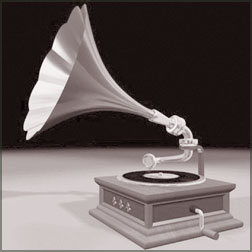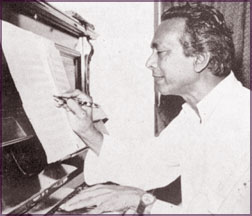Music that moves the human heart
By Sumathipala Solangaarachchi
Hindi music is very close to Sri Lankans in many aspects. First of
all, we have a culture that is closely related to the Indian
civilization. Our languages have the same Sanskrit foundation. We can
easily understand the emotions of Indian people.
Hindi music soothes minds. Melodies of Hindi songs were composed on
Ragas of North Indian classical music. All Ragas have individual
characteristics in rendering various expressions. Hindi film music
composers choose Ragas to stimulate the audience according to the moods
in the films. By the background music those maestros made the audience
thoroughly bound to the scenes.
|

Gramophones were used to listen to pre-recorded Hindi song
disks |
The famous saying that 'Music begins to talk where dialogues end'
reveals how strong their music is in captivating the audience to the
movie. Once, when Naushad Ali, the great Indian musician, was on a visit
to the USA an American inquired "What is the difference between your
music and ours?" and Naushad replied "Your music has power to move your
body, and our music has ability to move the human heart." Old Hindi
music also serves as a stress-healer for troubled minds. It tranquilizes
your disturbed mind, and thus makes you relaxed and healthy.
Music composed by Naushad Ali, Ravi, Salil Chaudhri, Roshan, Om
Prakash Nayyer, Narhar Chitalkar Ramachandra, Chitragupt, Allahrakkha
Qureshi, Usha Khanna, Khyyam, Sachin Dev Berman, S. N. Tripathi,
Saraswathi Devi, Anil Bishvas, Madan Mohan, G. S. Kohli, Jayadev, Bulo
C. Rani, R. C. Boral, Hemanth Kumar, Wasanth Desai, Hansraj Behel, Vinod
(Eric Robert), Snehal Baskar, Gyan Dutt, Gulam Haider, Gulam Mohamed,
Avinsh Vyas, Ravindra Jain, Master Mohamed, Shankar Rao Vyas, Sonik Omi,
Rahul Dev Berman and pairs of musicians Husnlal-Bhagatram,
Shankar-Jaikishan, Laxmikant-Pyarelal and Kalyanji-Anadji, (the 'Veerji
Shah' brothers), thoroughly grabbed the hearts of our fans.
Those musicians individually possessed their own styles of music and
some prominently used particular musical instruments in their creations.
Some were strictly in classical music; and some utilized folk music in
mixer. Some of them admixed with musical styles of foreign countries,
according to the status of the films they worked on. And they did not
discriminate the musical instruments whether they are 'western' or
'oriental', so that they obtained the exactly desired sounds, in their
creations.
|

Naushad Ali |
After all, every listener could enjoy music created so, regardless of
their nationality. The Hindi language, of course, is a very poetic and
rhythmic one which has very short and beautiful words with punching
accents. Sahir Ludhiyanavi, Majrooh Sultanpuri, Rajendra Krishan, Shakil
Badayuni, Anand Bakhshi, Shaylendra, Hasrat Jaypuri, S.H. Bihari, Bharat
Vyas, D.N. Madhok and Indeevar were some very talented Hindi lyricists
who wrote songs with punching words.
Singers of Hindi songs also contributed greatly to enhance the
elegance of that music by their wonderful voices; and ones like Asha
Bhonsle, Mohammed Rafi and Mahendra Kapoor by their effective accenting
of words too. Kundan Lal Sahegal, Noor Jehan, Suraiya, Zoharabai
Ambawali, Ashok Kumar, Shamshad Begam, Lata Mangeskar, Mohammed Rafi,
Geeta Dutt (nee Roi), Suman Kalyanpur, Mukesh Chand Mathur, Talat
Mahamud, Manna Day, Asha Bhonsle, Sandhya Mukharji, Hemanth Kumar, C. H.
Atma, Kishore Kumar, Usha Mangeskar and Mahendra Kapoor were very
brilliant vocalists since 1930s. Some of them had very punching voices,
while some possessed very soft and smooth voices. Some could change the
tones of their voices according to the moods of the songs.
Hindi songs were manifold in the purpose they were created for. They
can be initially categorized as sweet love songs, sad songs, divine or
faith songs, comic songs, joyful songs etc. The old Hindi musicians
chose singers to suit expected categories of songs. Some Hindi singers
had individual specialities for different moods. Asha Bhonsle has a very
sweet voice that has been taken for love songs and sometimes for amorous
and intoxicated moods.
The voice of Mukesh was required for where sorrow and softness
expected. Kishore Kumar formally has been singing comic songs with the
style called 'yodelling'; and later his voice was required for the
screen voice of the famous main actor Rajesh Khanna. Talat Mahamud who
was being titled 'King of Ghazal' had a very fine wavy voice that
specialized for sad songs.
Mohammed Rafi, having a strong masculine voice, was the most
versatile singer as he could change his voice-tone and accenting in film
songs to match the expected actions of the scenes. Rafi sang to suit the
playful action of Shammi Kapoor, fairly serious action of Bharat Bhushan
and for comic action of Johnny Walker and so on. Rafi has many sad songs
too.
In local practical music composing North Indian classical music is
mostly used or blended for building up a melody, first. And then, it is
decorated with some western musical techniques. Sometimes, a melody
based on local folk music is also used with the help of western musical
instruments and techniques. That is how the local practical music comes
to our ears.
Hindi musicians also do the same and thus the creations become very
rich. Oriental music is strictly melody oriented. Musicians first make a
melody and then choose chords and apply counter music. The union of
oriental music and western music is fortunately possible because the
note positions of both systems are on the same and exact audio
frequencies, and both systems use twelve semitones in an octave.
The average oriental listener expects a beautiful melody in a Hindi
or Sinhala song. Many good melodies of Hindi songs have deep seated in
our memories and never leave. Many melodies found in most of the new
films were not very tasty.
A good melody can be identified very simply by singing or humming it
without any instrumental sound; and if you think it is tasty, then is a
good one. For instance, sing a local folk song without instrumental
support, and you may feel it is sweet. Try a new song this way and you
can evaluate whether it could stay long in your memory. We can apply
this method to test any oriental melody.
Local old-timers used Short-wave (SW) radios to receive the signals
broadcast from India. "All India Radio" (AIR) broadcast their main
channel "Akashwani" on several frequencies in the SW meter-band of
radio. In 1957 "Vividh Bharati" service of AIR commenced, and was a very
attractive channel which brought much interesting musical programmes.
Theatres like CROWN in Maradana, RITZ and later LIDO in Borella were
prominent in Hindi film running and very favourite among Hindi movie
fans. Some so-called middle-class people possessed audio disk driving
machines called 'Gramophones', at home. This entirely mechanical device
reproduces sound by playing back the ebonite disks on which the song
sound tracks are recorded.
Pre-recorded Hindi song disks were imported from India. But due to
the limited availability of records, most people sat around the radio
set. Then the radio receiver was the favourite and widely used audio
equipment.
As the "Akashwani" and "Vividh Bharati" services were on Short Wave,
the local listeners also were fortunate to receive those channels on 49
and 31 meter-bands of SW. There was no FM transmission for public
entertainment, at the time, and only AM was in operation. The sound
reproduction on SW radio was heavily distorted due to AM systems suffer
various types of noise interferences, and due to the instability o the
layers of ionosphere. Because our country is in the fringe area of the
signal rain of AIR, and other technical reasons the reproduced radio
sound had fading effect too.
Some radio technicians managed to fine-tune their radio sets,
adjusting internal coils and trimmer capacitors to improve sensitivity
on those meter-bands, as they badly needed to enjoy Hindi songs. Even
today our old-timer fans amazingly prefer fading effect, as their taste
had been built up through so-received listening. That is a strong
testimony for how eagerly they admired 'Akashwani' and 'Vividh Bharati'
services received on short-wave.
People in Colombo and suburbs had an opportunity to listen to some
'Line Transmitted' local radio channels of the 'Radio Ceylon', by means
of a system called "Redifusion".
This service was rented for homes and shops in the town. The system
was operated just like the telephone line connection, provided with a
speaker-box, equipped for volume controlling and channel changing.
There was a very favourite Hindi commercial radio service operating
from the Torrington Square station of Radio Ceylon. This service was
dedicated only for Indian listeners and was transmitted on SW from Ekala
(close to Negombo) radio transmitting station. As the Torrington Square
radio station was the origin of this channel, the Colombo based 'Redifusion'
service conveyed it to their subscribers. Most of the people in Colombo
city preferred this channel Though not the local listener could properly
receive this channel on SW, another group of people had a casual chance
for very clear listening. People resided along the inter-station signal
beaming path from Colombo to Ekala, having FM radios, could receive this
channel on FM band. Signal to them was surprisingly clear and was an
exciting new experience, as the FM system suffers no interferences.
The 'Radio Ceylon' also had some Hindi song programmes on Medium Wave
local channels. A late-night Hindi musical programme was presented by
late veteran Hindi literate Ravi Lal Wimaladharma was a hot favourite,
as not only he gave the Sinhala meanings of the songs but also he had a
very smooth voice to match the mood.
Our old fans gratefully remember Mr. Wimaladharma for his
contribution to quench their thirst of Hindi music. Today, many local
radio channels and TV channels carry Hindi music in their programmes.
Smooth, sweet music is rare in most of the new films. Only a handful
of good songs can be found in the Hindi films produced after the 1980s.
But, Naushad Ali said, the good music will appear again, someday, on
public demand. Only good music will stay on.
Old Hindi Film and Song
Lovers' Society
An organization which is
formed of fans spread all over the island the objectives of
the Old Hindi Film and Song Lovers' Society include
gathering and preserving rare old Hindi songs and films,
distributing them among members, paving the way to exchange
them among members, organizing Hindi musical shows with
participation of the members and publishing various
literature concerning Hindi artistes and their masterpieces.
This society is backed by
many veteran artistes, eminent literates and prominent
citizens of the country. Many media institutions ardently
support this organization. The next Hindi musical show of
this society is scheduled to be held on the 22nd of March,
2008, at the BMICH. |
|
